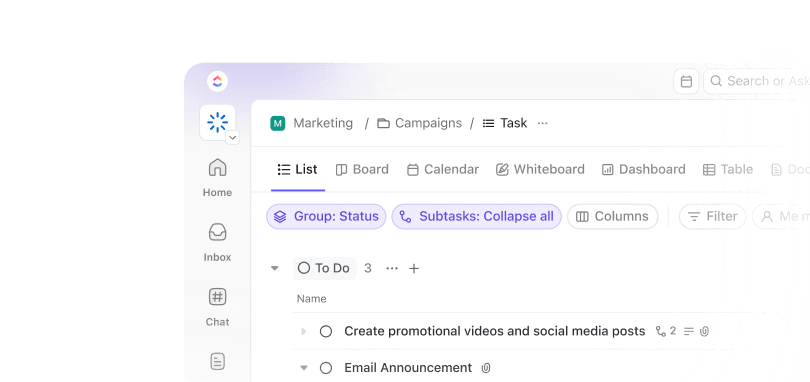When teams juggle too many tools, scattered data, and endless manual handoffs, work slows and mistakes multiply.
Nearly 47% of digital workers say they struggle to find the information they need to do their jobs.
Connected workflows fix this by linking your processes, people, and data across departments—so information moves automatically, everyone stays aligned, and your team can focus on work that actually moves the needle.
- What Are Connected Workflows?
- Connected Workflow Benefits for Modern Teams
- Eliminate manual data entry and human errors
- Accelerate project delivery with automated handoffs
- Gain real-time visibility across all departments
- Reduce operational costs through efficiency gains
- Improve team collaboration with shared context
- Scale operations without adding complexity
- Enhance compliance with automated audit trails
- Connected Workflow Use Cases Across Departments
- How to Implement Connected Workflows Step by Step
- How To Measure ROI From Connected Workflows
- How AI Supercharges Connected Workflow Benefits
- Transform Your Team’s Productivity With Connected Workflows
- Frequently Asked Questions
What Are Connected Workflows?
Connected workflows are integrated systems that sync data, tasks, and decisions across your tools and teams. Think of them as the digital highways that remove silos: instead of passing information through emails or chat messages, work moves forward automatically through triggers, rules, and real-time updates.
This fragmentation across tools is classic Work Sprawl. Context lives in ten different places, and teams lose hours stitching it back together. A Converged AI Workspace stops that fragmentation by unifying tasks, conversations, documents, and automations in one place so information flows naturally instead of being hunted down.
A strong, connected workflow includes three parts:
- Automation triggers: Events that kick off the next step (e.g., “form submitted” → create a task)
- Data synchronization: Updates made in one system instantly reflect in all connected tools
- Cross-functional visibility: Everyone sees progress in real time without chasing updates
By eliminating manual work, connected workflows reduce errors, speed up execution, and help teams make decisions based on one unified source of truth.
📮 ClickUp Insight: 1 in 4 employees uses four or more tools just to build context at work. A key detail might be buried in an email, expanded in a Slack thread, and documented in a separate tool, forcing teams to waste time hunting for information instead of getting work done.
ClickUp converges your entire workflow into one unified platform. With features like ClickUp Email Project Management, ClickUp Chat, ClickUp Docs, and ClickUp Brain, everything stays connected, synced, and instantly accessible. Say goodbye to “work about work” and reclaim your productive time.
💫 Real Results: Teams can reclaim 5+ hours every week using ClickUp—that’s over 250 hours annually per person—by eliminating outdated knowledge management processes. Imagine what your team could create with an extra week of productivity every quarter!
🐣 Fun Fact: The earliest “workflow systems” were literally paper routing slips attached to physical manila folders. If someone took a sick day… the entire workflow took a sick day too.
Connected Workflow Benefits for Modern Teams
Connected workflows are no longer optional, they’re essential for distributed teams that want to move fast without sacrificing quality. Here’s what they unlock. ✨
Eliminate manual data entry and human errors
No more copying information between tools or updating spreadsheets. Connected workflows sync your data instantly everywhere it needs to be.
Example:
When a deal closes in your CRM, it can automatically create a project in ClickUp and update revenue projections, eliminating the need for human intervention.
Organize this flow with ClickUp’s Workspace Hierarchy (Spaces → Folders → Lists), ensuring every automated update lands exactly where it belongs.

💡 Pro Tip: Start with the workflow that annoys you the most.
Don’t try to automate your entire universe on day one. Pick the process that consistently trips your team up—expense approvals, content QA, lead assignments—and connect just that first. You’ll get faster adoption and a quick win you can scale.
Accelerate project delivery with automated handoffs
Work reaches the right person at the right time, automatically.
Example:
A writer marks a blog post as “Ready for Edit.”
A workflow instantly assigns it to the editor, notifies them, and updates the deadline.
You can manage even the most complex approval routing with ClickUp Automations Triggers. These triggers can use conditional logic based on task details, so a budget request over $500 automatically goes to a manager for approval, while smaller requests are approved instantly.

Here’s what a G2 reviewer had to say about ClickUp:
Gain real-time visibility across all departments
Get a clear view of everything that’s happening without having to chase down updates. Instead of relying on weekly status meetings, you can see project progress, identify bottlenecks, and track team workloads at a glance. This level of process visibility enables real-time collaboration, made possible with dashboards that pull live data from all your connected tools.
You can create a central command center for your projects with ClickUp Dashboards. These dashboards give you a high-level overview by converting your workspace data into easy-to-understand charts and graphs, showing you exactly where work stands at any moment.
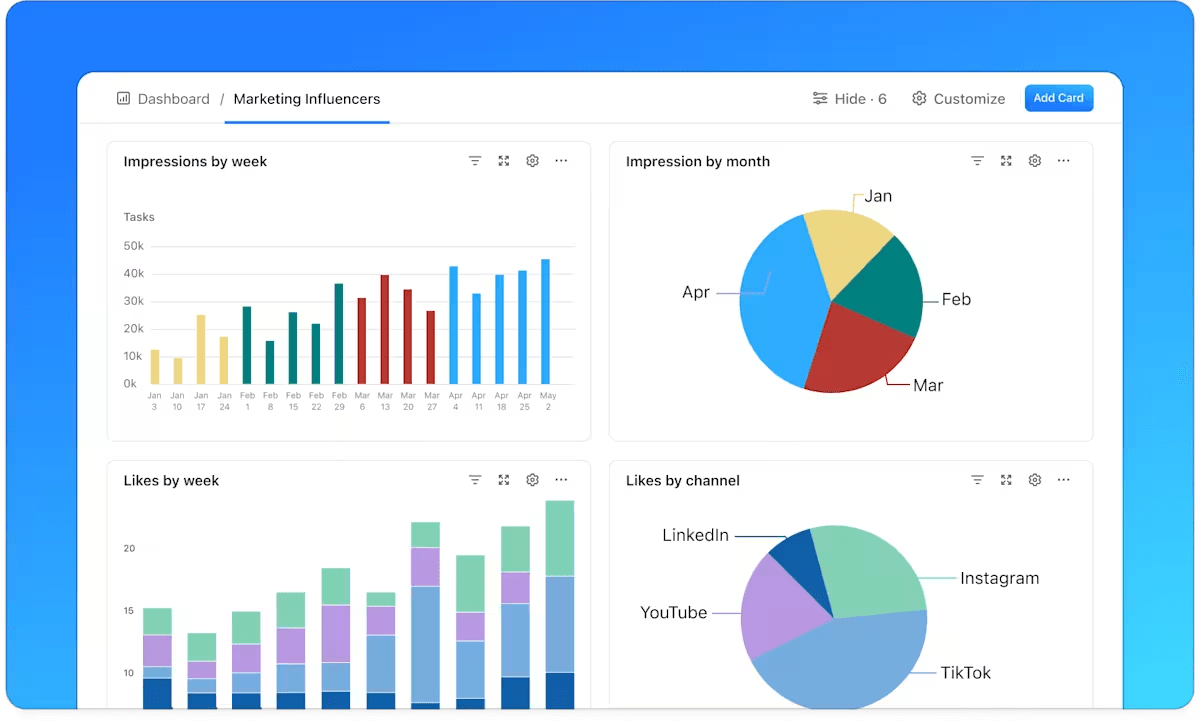
💡 Pro Tip: Build workflow “checkpoints.”
Before you connect apps or build automations, drop tiny checkpoints into your process (like “Is all required info captured?” or “Has design reviewed this?”). These micro-prompts prevent downstream chaos and make your workflow 2× more reliable.
Reduce operational costs through efficiency gains
One of the biggest advantages of automation is the boost in operational efficiency, which leads to significant cost savings. By cutting down on manual work, you reduce the time your team spends on low-value administrative tasks. This frees them up to focus on strategic initiatives that actually drive revenue.
Fewer errors also mean less time and money spent on rework. Plus, with better resource allocation, you can see who’s overworked and who has capacity, allowing you to balance workloads and avoid burnout. This helps you optimize your existing team and avoid unnecessary hiring.
📮 ClickUp Insight: 30% of workers believe automation could save them 1–2 hours per week, while 19% estimate it could unlock 3–5 hours for deep, focused work.
Even those small time savings add up: just two hours reclaimed weekly equals over 100 hours annually—time that could be dedicated to creativity, strategic thinking, or personal growth.💯
With ClickUp’s AI Agents and ClickUp Brain, you can automate workflows, generate project updates, and transform your meeting notes into actionable next steps—all within the same platform. No need for extra tools or integrations—ClickUp brings everything you need to automate and optimize your workday in one place.
💫 Real Results: RevPartners slashed 50% of their SaaS costs by consolidating three tools into ClickUp—getting a unified platform with more features, tighter collaboration, and a single source of truth that’s easier to manage and scale.
Improve team collaboration with shared context
When everyone is working from the same playbook, team collaboration becomes effortless. Connected workflows ensure that all comments, files, and decisions are attached to the work itself, so no one is left digging through emails to find the latest version of a file. This eliminates context sprawl—when teams waste hours searching for information, switching between apps, and hunting down files across disconnected platforms—that happens when information is scattered across too many apps.
Keep all your work in one place so your team always has the full story. Because tasks, documents, and conversations are connected, your team always has the full story. When a new person joins a project, they can get up to speed quickly without having to ask what’s already been decided.

👀 Did You Know? In companies with disconnected workflows, 60% of project delays come from handoff failures—not skill gaps or poor planning.
Scale operations without adding complexity
As your business grows, a smart operations strategy ensures your processes don’t become more complicated. Connected workflows are built to scale, handling an increase in volume without requiring you to hire more people to manage the manual work. Whether you’re processing 10 invoices or 1,000, the automated workflow handles it the same way.
This allows you to grow your company’s output without proportionally increasing your operational overhead. Your systems do the heavy lifting, so your team can stay focused on innovation and customer value.
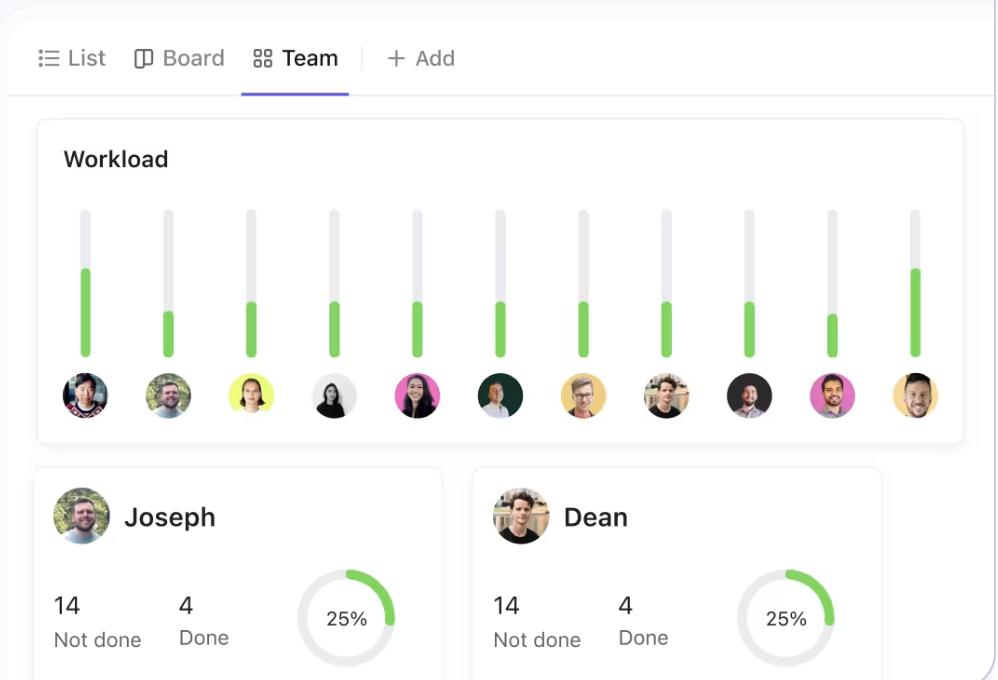
Enhance compliance with automated audit trails
Stay ready for any audit with workflows that automatically document every step of your process. For regulated industries like finance or healthcare, this level of project compliance is a game-changer. Every approval, status change, and decision is time-stamped and recorded, creating an immutable audit trail.
Easily track this history with ClickUp’s Audit Trail feature, which logs key events like role changes, task deletions, and ClickUp Custom Fields modifications.
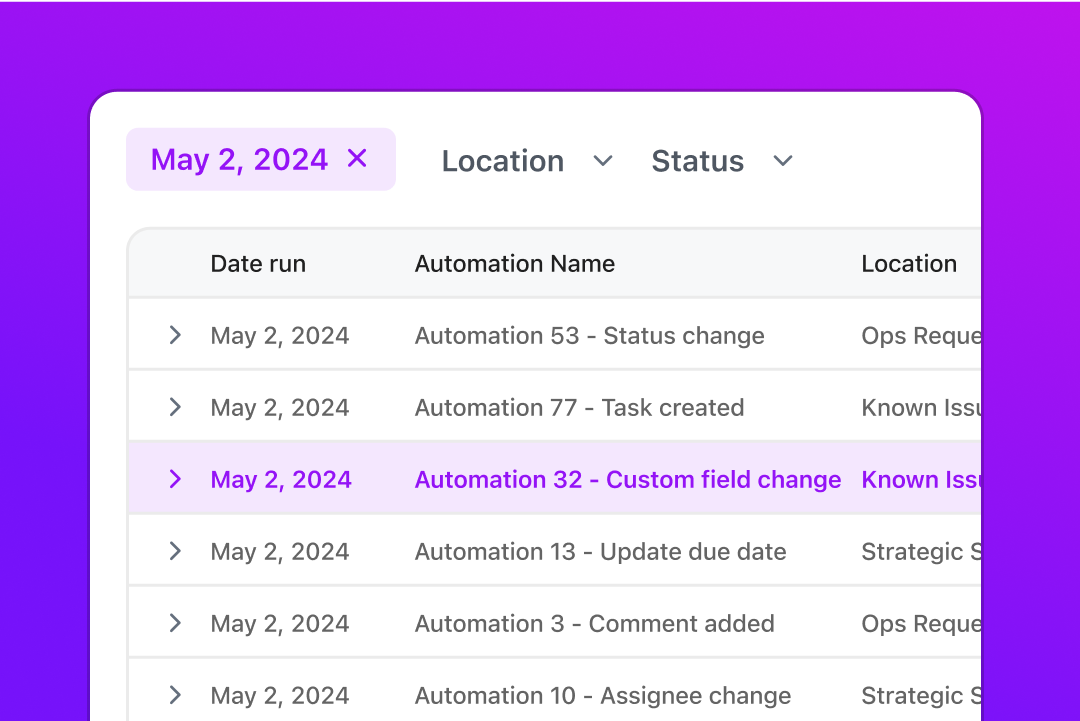
Connected Workflow Use Cases Across Departments
Connected workflows aren’t just for one team—they can transform how every department operates. The real magic happens when you connect processes between departments, creating a unified system for your entire organization. Here are a few examples. 🛠️
Operations and project management workflows
For teams that live and breathe projects, connected workflows are the key to staying on track and on budget.
- Resource allocation: Automatically assign tasks to team members based on their current workload and skills. You can build a workflow that checks everyone’s capacity before assigning new work, ensuring no one gets overloaded
- Task dependencies: Keep your project timelines accurate without manual adjustments. With ClickUp Task Dependencies, completing one task can automatically trigger the start of the next, and any delays in a critical task can reschedule all dependent work
- Status reporting: Stop spending hours manually compiling progress reports. You can set up automated workflows that generate and send status reporting updates to stakeholders every week, pulling live data directly from your projects

Cross-functional business processes
Some of the most impactful workflows are those that cross departmental lines.
- Lead routing: When a new lead comes in from your website, a workflow can instantly analyze it. Based on the lead’s location, company size, and interests, it can be automatically assigned to the right salesperson for follow-up.
- Employee onboarding: The moment a new hire signs their offer letter, you can trigger a comprehensive employee onboarding workflow. This can create tasks for IT to set up their equipment, for HR to send paperwork, and for their manager to schedule their first week of meetings—just one of many workflow examples you can build.
- Purchase approvals: Streamline how your company spends money. An employee can submit a purchase request through a form, and a workflow can automatically route it for purchase approvals based on the amount and department, ensuring it gets to the right people without delay.

How to Implement Connected Workflows Step by Step
Putting connected workflows into practice is more about planning than technology. Before you even think about tools, you need to understand how your team works now. A great way to start is by structuring your work logically. For example, ClickUp’s workspace hierarchy lets you organize work into Spaces, Folders, and Lists, which provides a natural foundation for building your automated workflow systems.
Map your current processes and identify bottlenecks
The first step is to see where your work is getting stuck. A technique called value stream mapping can help you visualize your current processes and find hidden delays.
- Document the current state: Write down every single step in a key process, from start to finish. Note who is responsible for each step and what tools they use
- Identify wait times: Pinpoint where work sits idle. This often happens when a task is waiting for approval or a handoff to another team
- Find manual handoffs: Look for any point where information is passed from one person to another via email, chat, or a meeting. These are prime opportunities for automation
- Measure cycle time: Clock how long it takes for a process to complete, from the initial request to the final delivery. This gives you a baseline to measure your improvements against
Design your connected workflow architecture
Once you know what to fix, you can start designing your new, connected process. This involves planning out the technical details to make sure everything runs smoothly.

- Define triggers: Decide what event will kick off your workflow. Will it be when a task status changes, a form is submitted, or a due date arrives? ClickUp offers a wide range of Automation triggers to start your workflows
- Set conditions: Create rules that guide the workflow. For example, “If the budget is over $1,000, then send it to the finance director for approval”
- Establish integrations: Figure out which of your existing tools need to talk to each other. You can use webhook triggers or native integrations to connect your apps and ensure data flows seamlessly.
- Assign process owners: Designate a person who is responsible for maintaining each workflow. This person will be the go-to for making updates and troubleshooting any issues
Ready to see workflow automation in action? Watch this quick tutorial that demonstrates exactly how to set up AI-powered automations in ClickUp in less than 5 minutes—no coding required.
Here’s a quick look at how things change when you move to a connected system.
| Disconnected Workflows | Connected Workflows |
|---|---|
| Manual status updates via email | Automatic progress tracking in real-time |
| Spreadsheet-based approval tracking | In-system approval routing with notifications |
| Weekly status meetings for updates | Real-time dashboards with live data |
| Separate tools for each department | Unified workspace with integrated data |
How To Measure ROI From Connected Workflows
The return on investment (ROI) from connected workflows shows up in two ways: immediate time savings and long-term improvements in quality. To prove the impact, it’s essential to track your performance before you make any changes. This gives you a clear “before and after” picture.
Key metrics to track workflow performance
To see how well your new workflows are performing, keep an eye on these key productivity metrics.
- Time to completion: This measures the total time from when a task starts to when it’s finished. A shorter completion time means you’re delivering value faster.
- Error rates: Track how often mistakes happen that require rework. A lower error rate is a direct sign of improved quality and reduced waste.
- Throughput: This refers to the amount of work your team accomplishes within a specified period. Higher throughput means your team is getting more done without working longer hours.
- Resource utilization: This metric indicates the proportion of your team’s time dedicated to valuable work versus administrative tasks. The goal is to maximize time spent on activities that matter.
Calculate time and cost savings
You can calculate your ROI with a simple formula: (Hours Saved per Week × Average Hourly Rate × 52) – Initial Cost = Annual ROI.
For example, if you save your team 10 hours a week and the average hourly rate is $40, that’s $20,800 in savings per year. Don’t forget to account for both hard savings (like not needing to hire another person) and soft savings (like your team having more time for creative and strategic work).
How AI Supercharges Connected Workflow Benefits
AI-powered automation is taking connected workflows to the next level. Studies show productivity increases of 14 percent when teams use AI assistants in their workflows. Instead of just following pre-set rules, AI can learn, adapt, and make your automated processes even smarter. It acts as an intelligent layer on top of your workflows, understanding context and making suggestions to improve efficiency. 🤩
Ask questions about your work in plain English and get instant answers with ClickUp Brain. And with ClickUp Brain MAX, our desktop AI companion, you can extend these capabilities across all your apps while staying connected to your ClickUp workspace.
💡 Pro Tip: Add AI summaries at every handoff.
Use ClickUp Brain/Agents to automatically summarize progress, blockers, and next steps whenever a task moves to a new stage. This prevents the classic “What’s the latest?” scavenger hunt.
Intelligent automation that adapts to patterns
AI-powered workflows get better over time by learning from your team’s activities.
- Smart routing: Instead of just assigning tasks in a round-robin fashion, AI can determine the best person for the job based on their current workload, skills, and past performance on similar tasks.
- Predictive delays: AI can analyze your project data to identify tasks that are at risk of missing their deadlines, giving you a heads-up so you can take action before it’s too late.
- Anomaly detection: AI can flag unusual activity that might need a human eye, like a purchase request that’s much higher than normal or a task that’s been stuck in the same status for too long.
Natural language workflow creation
Forget about complicated setup menus. With AI, you can build powerful automated workflow systems just by describing what you want to happen. For instance, you can simply tell ClickUp Brain, “When a task is marked as urgent, notify the project manager and add it to the top of their to-do list.” The AI will understand your intent and build the entire workflow for you, complete with the right triggers and actions.
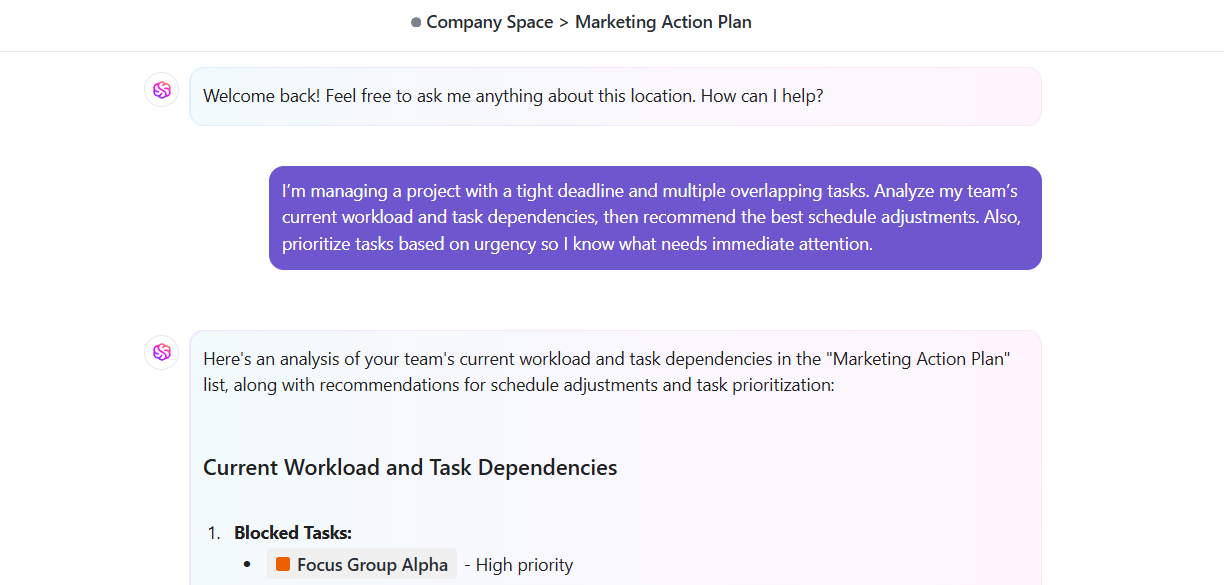
Let ClickUp agents run your connected workflows automatically
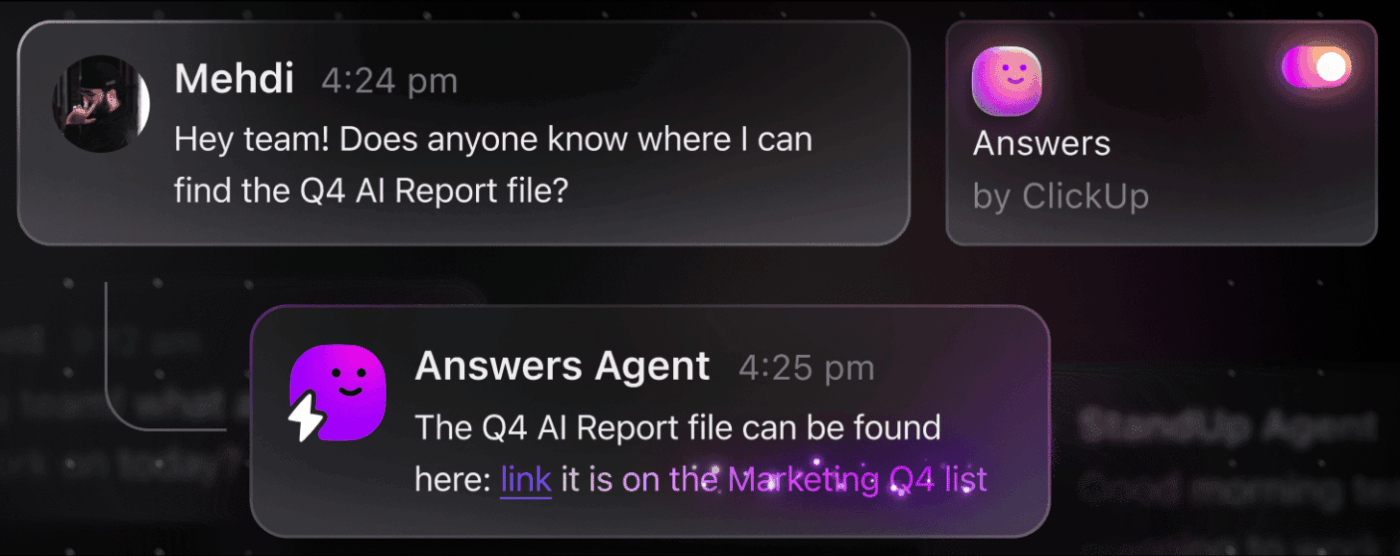
ClickUp Agents act like always-on teammates, keeping your workflows moving. They monitor status changes, overdue tasks, stalled projects, missing handoffs, or incomplete steps, and then route work, notify owners, or generate updates automatically. Agents ensure that connected workflows remain connected, even when your team is busy or offline.
Transform Your Team’s Productivity With Connected Workflows
Connected workflows are more than just a productivity hack—they represent a fundamental shift in how modern teams accomplish their work. By moving away from fragmented tools and manual processes, you empower your team to focus on what they do best: solving problems, being creative, and delivering value to your customers. The result isn’t just a more efficient business, but a happier and more engaged team.
You don’t have to boil the ocean to get started. Pick one process that’s causing your team the most pain—like expense reporting or content approvals—and connect it. Once you see the benefits, you can expand from there. Over time, these small wins add up, transforming your entire organization.
Ready to eliminate work sprawl—the fragmentation of work across disconnected tools that drains team productivity—and see what your team can really do? Get started for free with ClickUp today.
Frequently Asked Questions
What is the difference between workflow automation and connected workflows?
Workflow automation focuses on a single process within one tool, while connected workflows link multiple automated processes across different departments and systems. This creates a seamless, end-to-end flow of information and work.
How long does it take to see ROI from connected workflows?
Most teams start seeing measurable time savings within the first 30 days. Depending on the complexity of the workflows you build, you can typically expect to see a full return on investment in three to six months.

